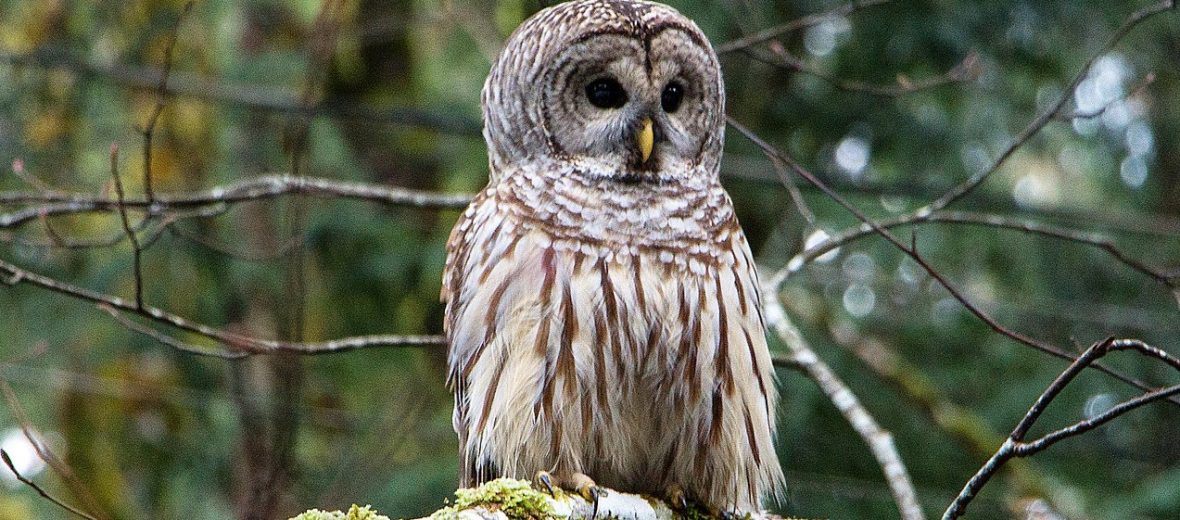
The barred owl, aka northern barred owl, eight hooter, hoot owl, rain owl, striped owl, or wood owl, hails from Canada, eastern United States, and Mexico. These owls have also begun moving into the west coast of North America, where they’re considered invasive. They prefer coniferous forests, old deciduous, and mixed forests. However, they can also be found in semi-open wooded areas, deep moist forests, oak savannas, cabbage-palm regions, riparian areas, swampy environments, wetlands, agricultural fields, open terrains, and large parks – as long as they provide the cover of old growth trees. Due to increasing and stable numbers, throughout their range, as well as their tendency to be invasive, these birds of prey are listed as Least Concern by the IUCN.
First the Stats…
Scientific name: Strix varia
Weight: Up to 1.6 lbs.
Length: Up to 20 inches
Wingspan: Up to 60 inches
Lifespan: Up to 23 years
Now on to the Facts!
1.) A barred owl can carry away prey items weighing up to 5 lbs.!
2.) Barred owls have begun to encroach on the territories of the Near Threatened spotted owl.
3.) As a result of the encroachment of these owls into the territories of the spotted owl, some biologists have recommended culling barred owls to aid the spotted owls.
4.) These owls are predominantly nocturnal (active at night). However, they occasionally have been seen active during the day.
5.) Barred owls are very territorial and aggressive towards intruders.
But wait, there’s more on the barred owl!
6.) Territories are denoted by singing and patrolling.
7.) They have around 8 known distinctive calls.
Did you know…?
Like other owls, their ears are set at different points on their head to allow for better hearing of smaller prey.
8.) A group of owls, although rare, is called a stare or parliament.
9.) Mice; rats; other rodents; amphibians; reptiles; birds; and sometimes even fish are all on the menu.
10.) The barred owl is monogamous (mates for life).
But wait, there’s still more on the barred owl!
11.) Courtship involves bowing with half-open wings, nodding, wobbling, and twisting their head from side to side.
12.) Nest sites are usually set in the deeper, darker parts of their forested habitat; and they’re close to water, but about 40+ feet off the ground.
Did you know…?
If a fledgling falls from the nest, they can usually climb back up the tree using their talons and beak to hang on to the bark. They then scale back up to the nest, flapping their wings the whole way up.
13.) Females lay up to 3 eggs that hatch in up to 28 days.
14.) The female will incubate the eggs while the male brings back food.
15.) There are approximately 3,000,000 adult, wild individuals known to exist.
But wait, there’s still more on the barred owl!
16.) Barred owls are the only known true owl, in North America, that has brown eyes. Other owls have orange or yellow eyes.
17.) Due to their soft and serrated feathers, and subsequent silent flight, these birds can get as close as 33 feet or less from their prey before attacking.
18.) These owls are known to be curious of humans and among the more mild mannered of captive owls.
19.) After eating enough crayfish, the feathers on the belly of these owls becomes a pinkish color.
20.) Raccoons, weasels, great horned owls, and northern goshawks all prey on these owls or their eggs.
Now a Short Barred Owl Video!
Be sure to share & comment below! Also, check out the Critter Science YouTube channel. Videos added regularly!
Want to suggest a critter for me to write about? Let me know here.



